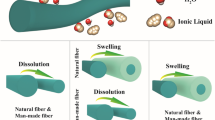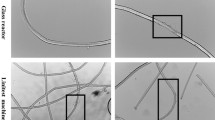Abstract
The influences of temperature, concentration of swelling agents and fiber materials on the fibrillation tendency in various cellulosic fibers in aqueous solutions were investigated in terms of fibrillation stability and fibrillation sensitivities to alkali and heat. The fibrillation stability and the fibrillation sensitivity to swelling agents were evaluated with a critical point of fibrillation (CPFconc.) that is the concentration of the swelling agents where fibrillation begins, and the ratio of initial increase in fibril number to increase in concentration of swelling agent (I i ). The fibrillation sensitivity to heat was estimated with the increase in I i against temperature. The CPFconc. of lyocell fiber was 16.7 mol/l water in ethanol/water mixture at 25 °C and decreased to 0 mol/l at 80 °C, indicating acceleration of the fibrillation at higher temperatures. The I i of lyocell was enhanced from 3.50 to 7.57 count l/mol. The CPFconc. increased in the order of viscose > cross-linked lyocell > modal > lyocell while the I i decreased in the order of viscose < modal < cross-linked lyocell < lyocell at 40 °C. The I i of lyocell fiber increased to the greatest extent with increase in temperature as compared with the other cellulosic fibers. Lyocell fiber has the lowest fibrillation stability and the highest fibrillation sensitivities to alkali and to heat resulting in the highest fibrillation tendency.
Similar content being viewed by others
Abbreviations
- CPFconc.:
-
critical point of fibrillation mol/l
- Ii:
-
ratio of initial increase in fibril number to increase in concentration of swelling agent count · l/mol
References
F. Brauneis M. Eibl (1998) ArticleTitleFinishing of knitgoods produced from Lenzing Lyocell Melliand Textil. 79 IssueID3 155–156
H.-P. Fink P. Weigel H.J. Purz J. Ganster (2001) ArticleTitleStructure formation of regenerated cellulose materials from NMMO-solutions Prog. Polym. Sci. 26 1473–1524 Occurrence Handle10.1016/S0079-6700(01)00025-9
J. Lenz J. Schurz E. Wrentschur (1992) ArticleTitleComparative characterization of solvent spun cellulose and high wet modulus viscose fibres by their long periods Acta Polymer. 43 307 Occurrence Handle10.1002/actp.1992.010430603
A. Nechwatal M. Nicolai K.-P. Mieck (1996a) ArticleTitleCrosslinking reactions of spun-wet NMMO fibers and theory influence on fibrillability Text. Chem. Color. 28 IssueID5 24–27
A. Nechwatal M. Nicolai K.-P. Mieck (1996b) ArticleTitleTextile crosslinking reactions to reduce the fibrillation tendency of lyocell fibers Text. Res. J. 66 IssueID9 575–580
H. Nemec (1994) ArticleTitleFibrillation of cellulosic materials – Can previous literature offer a solution? Lenzinger Berichte 74 69–72
M. Nicolai A. Nechwatal K.-P. Mieck (1998) ArticleTitleModified fibrillation behavior of solvent-spuncellulose fibers by the reaction with reactive dyes Angew. Makromol. Chem. 256 21–27 Occurrence Handle10.1002/(SICI)1522-9505(19980401)256:1<21::AID-APMC21>3.3.CO;2-W
Okubayashi S., Griesser U. and Bechtold T. 2004. A kinetic study of moisture sorption and desorption on lyocell fibers. Carbohyd. Polym. in press.
C. Rohrer P. Retzl H. Firgo (2001) ArticleTitleLyocell LF – profile of a fibrillation-free fibre from Lenzing Lenzinger Berichte 80 75–81
W. Zhang S. Okubayashi T. Bechtold (2003) ArticleTitleModification of fibrillation by textile chemical processing Lenzinger Berichte 82 58–63
Zhang W., Okubayashi S. and Bechtold T. 2004. Fibrillation tendency of cellulosic fibers – Part 1. Effects of swelling. Cellulose submitted.
Author information
Authors and Affiliations
Corresponding author
Rights and permissions
About this article
Cite this article
Zhang, W., Okubayashi, S. & Bechtold, T. Fibrillation Tendency of Cellulosic Fibers. Part 2: Effects of Temperature. Cellulose 12, 275–279 (2005). https://doi.org/10.1007/s10570-004-2787-y
Received:
Accepted:
Issue Date:
DOI: https://doi.org/10.1007/s10570-004-2787-y




